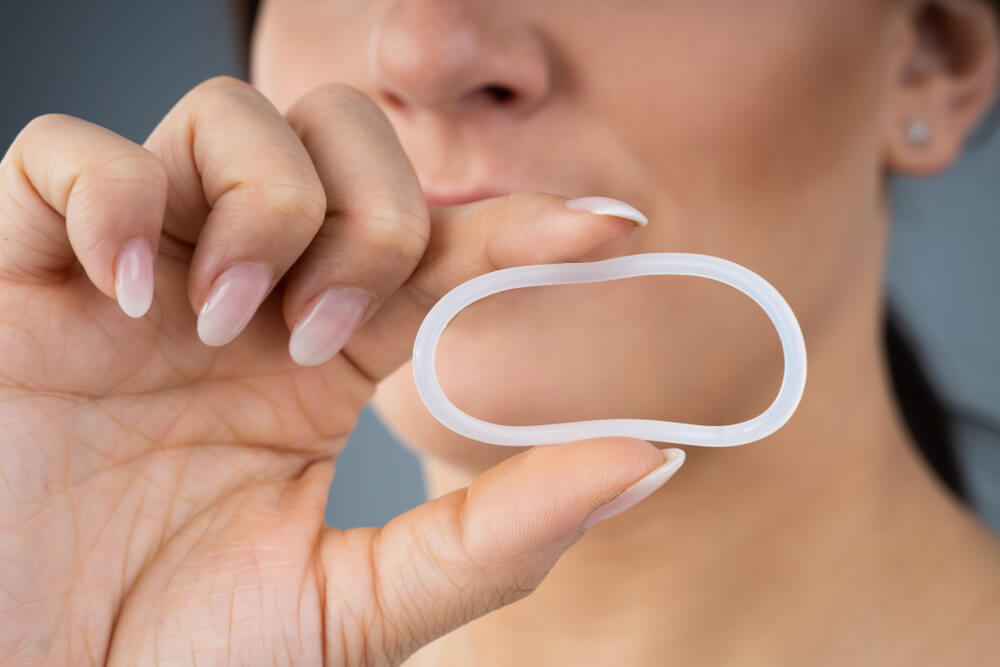Welcome to our expert-revised guide on the birth control ring and its efficacy rate in preventing unwanted pregnancy. You’re in the right place if you’re considering using a vaginal ring as your contraceptive method. In this guide, we’ll provide you with all the information you need to know to use the birth control ring properly and avoid unwanted pregnancy. Throughout this guide, we’ll answer commonly asked questions like “What is a vaginal ring?” and “How does a vaginal ring work?” You’ll also learn about the benefits, risks, and potential side effects of using a birth control ring, so you can decide whether it’s the right contraceptive option for you.
Our clinic’s dedicated to providing our patients with the highest quality of care and personalized health advice. So, if you’re searching for the best birth control options, don’t hesitate to contact us today.
With all of this in mind, scroll on and find out “what is a vaginal ring?” and much more.
Vaginal Ring or Birth Control Ring: Must-Know Facts

Before uncovering the answer to “How does a vaginal ring work?” let’s discuss what this contraceptive method refers to.
In short, the birth control ring, also known as the vaginal ring, is a flexible, plastic ring that is inserted into the vagina to prevent unwanted pregnancy. It contains synthetic versions of the hormones estrogen and progestin, which are gradually released into the body over a period of three weeks. The ring is then removed for a week, during which a woman will have her menstrual period and a new ring is inserted.
One of the advantages of the vaginal ring is its high efficacy rate, which is over 99 percent when used correctly. This makes it an ideal option for women who are looking for a convenient and reliable form of birth control.
To use the vaginal ring, a woman must first consult with a medical professional to determine if it is a suitable option for her. The ring is then inserted into the vagina and left in place for three weeks, after which it is removed for a week to allow for menstruation. It can be easily inserted and removed by the woman herself, making it a convenient option for those who are busy or on the go.
However, while the vaginal ring is highly effective at preventing pregnancy, it does not protect against sexually transmitted infections. Therefore, it is recommended that sexually active women use additional protection, such as condoms, to reduce the risk of contracting STIs.
Does the Vaginal Ring Have Adverse Effects?
Now that you know the answer to “What is a vaginal ring?”, let’s briefly discuss the side effects – because every birth control method has some!
Some common side effects of using the vaginal ring include:
- Headaches
- Nausea
- Breast tenderness
- Spotting
- Acne
- Low libido (sex drive)
- Weight gain
- Mood swings and depression
Fortunately, these symptoms usually subside within a few months of use, but if they persist or worsen, a woman should consult with her healthcare provider.
In conclusion, the vaginal ring is a highly effective form of birth control that is easy to use. However, consulting with a medical professional such as Dr. Jessica White is essential to determine if it is the right option for you. As with any form of birth control, it is best to use additional protection against sexually transmitted infections and closely monitor any potential side effects.
How Does a Vaginal Ring Work as a Contraceptive?
The ring releases hormones (progestin and estrogen) into the bloodstream, which works to prevent ovulation. The vaginal ring also thickens cervical mucus, which makes it more difficult for sperm to reach the egg. Without ovulation, there is no egg for sperm to fertilize, meaning pregnancy cannot occur.
Remember that the vaginal ring does not protect against sexually transmitted infections (STIs). If you are sexually active and want to reduce your risk of getting an STI, it’s essential to use a barrier method of contraception like condoms in addition to the vaginal ring.
Who May Not Be Eligible for Using a Birth Control Ring?
While the birth control ring is generally safe and effective for most women, there are some cases where it may not be a suitable contraceptive method. Here are some factors to consider:
- Women who smoke or have a history of blood clots should not use the birth control ring, as it can increase the risk of developing blood clots.
- Women with breast cancer or a history of certain liver or heart conditions should consult with their doctor before using the birth control ring.
- Women who are allergic to any of the components in the ring should not use it.
- Women with unexplained vaginal bleeding should consult their doctor before using the ring.
- Women who are pregnant or breastfeeding should not use the birth control ring.
Whether you are curious about “How does a vaginal ring work?” or the advantages and side effects of its use, we suggest consulting with trusted professionals.
Why Do Some Women Prefer Using a Birth Control Ring?
There are a few good reasons why women opt for a vaginal ring as a birth control option. For example, consider the following:
- High efficacy rate: The vaginal ring is highly effective in preventing pregnancy, with a success rate of 99%. This is because it releases a consistently low hormone dose, inhibiting ovulation.
- Convenience: The woman can easily insert and remove the ring without needing a medical professional.
- Long-lasting protection: The vaginal ring protects for up to 3 weeks, so women do not have to worry about taking a pill daily.
- Reduces menstrual symptoms: The hormones released by the vaginal ring can help alleviate symptoms such as heavy bleeding, cramps, and irregular periods.
- Safe for most women: The vaginal ring is generally safe for most women and does not carry the risk of severe side effects.
The Two Types of Birth Control Rings to Consider
Currently, two types of vaginal rings are available on the market, NuvaRing or EluRyng and Annovera. Both are designed to release hormones and prevent unwanted pregnancy in women. Take a look at this brief overview of the two types:
Facts About EluRyng or NuvaRing :
- It contains both estrogen and progestin hormones.
- Must be replaced once a month.
- Provides 99% effectiveness in preventing pregnancy when used correctly.
- It can reduce menstrual cramps and make periods more regular.
- It can help manage symptoms of conditions like endometriosis and polycystic ovary syndrome (PCOS).
Facts About Annovera:
- Contains only progestin hormone.
- It can be reused for up to a year.
- Provides 97% effectiveness in preventing pregnancy when used correctly.
- This may lead to lighter periods and fewer cramps.
- It may be a more convenient option for women who don’t want to replace the ring every month.
Inserting the Vaginal Ring: What You Must Know

Inserting a vaginal ring is a simple process that can be done at home or under the guidance of a medical professional. Here are some steps to insert the ring:
- Wash your hands with soap and water to avoid infection.
- Choose a comfortable position, such as lying down or squatting.
- Use one hand to hold the ring and squeeze it into an oval shape.
- Use the other hand to gently insert the ring into the vagina, similar to inserting a tampon.
- Push the ring in until it is comfortable and in the proper position. Most women find it sits comfortably behind the pubic bone.
Follow the instructions provided by your healthcare provider to ensure proper insertion and avoid any potential risks or complications.
Give Us a Call Today
Book a schedule with us today and learn everything you want about the vaginal ring as an effective contraceptive method. Ideal Our compassionate team of healthcare professionals at Ideal Women’s Health Care is dedicated to ensuring your well-being in a safe and supportive environment. Give us a call!


